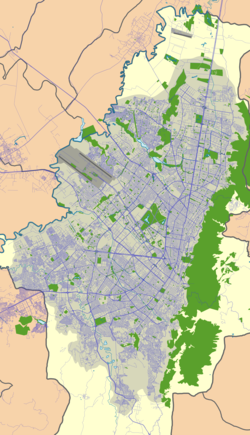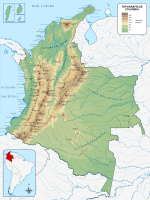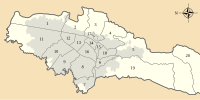List of flora and fauna of the Eastern Hills, Bogotá
The Eastern Hills of Bogotá is a threatened but rich area of biodiversity. Various species have been registered in the Eastern Hills of the Colombian capital.
Flora[edit]

In the Eastern Hills a total of 443 species of flora have been identified, of which 156 species in 111 genera and 64 families of vascular plants.[1]
| Family | Genera | Species |
|---|---|---|
| Orchideae | 33 | 118 |
| Bromeliaceae | 10 | 47 |
| Asteraceae | 9 | 38 |
| Ericaceae | 8 | 19 |
| Melastomaceae | 9 | 18 |
| Rosaceae | 6 | 15 |
| Rubiaceae | 6 | 11 |
A study published in 2013 lists as most important and characteristic species:[2][3][4][5][6]
Birds[edit]
Colombia is the country with the most recorded bird species (1912 as of 2014) in the world.[7] The biodiversity of bird species in the Eastern Hills is higher than in the parks of urban Bogotá. The northern part of the reserve is richer in bird species due to the dense forests and larger space between the urban zones. Birds of 30 families, 92 genera and 119 species have been identified in the Eastern Hills.[1] A study in 2011 provided data on 67 species in an area of 75 hectares (190 acres).[8] The observation stations were between 2,674 metres (8,773 ft) and 3,065 metres (10,056 ft) in elevation.[9]
Mammals[edit]
Mammals of 14 families, 17 genera and 18 species have been identified in the Eastern Hills.[1][10] Until the first half of the twentieth century, the Eastern Hills were populated by larger species as the puma, spectacled bear and white-tailed deer, but these species have been hunted to extinction.[11]
| Common name | Species | Image |
|---|---|---|
| crab-eating fox | Cerdocyon thous |  |
| mountain paca | Cuniculus taczanowskii |  |
| white-eared opossum | Didelphis albiventris |  |
| eastern red bat | Lasiurus borealis |  |
| oncilla | Leopardus tigrinus |  |
| long-tailed weasel | Mustela frenata |  |
| western dwarf coati | Nasuella olivacea |  |
| red-tailed squirrel | Sciurus granatensis |  |
| tapeti | Sylvilagus brasiliensis |  |
| soft-furred Oldfield mouse | Thomasomys laniger | |
| snow-footed Oldfield mouse | Thomasomys niveipes | |
| Thomas' small-eared shrew | Cryptotis thomasi | |
| Cavia anolaimae |
Reptiles[edit]

Reptiles of four families, five genera and five species have been identified in the Eastern Hills.[1][10] Of these species, only the lizards Anadia bogotensis and Proctoporus striatus have been found on the Guadalupe Hill.[12] The striped lightbulb lizard is also present on the terrain of the Universidad de los Andes.[13]
| Common name | Species | Image |
|---|---|---|
| flat Andes anole | Phenacosaurus heterodermus |  |
| striped lightbulb lizard | Proctoporus striatus |  |
| Duméril's whorltail iguana | Stenocercus trachycephalus | |
| thickhead ground snake | Atractus crassicaudatus | |
| Anadia bogotensis |
Amphibians[edit]
Amphibians of four families, six genera and nine species have been identified in the Eastern Hills.[1][10][11]
| Common name | Species | Image |
|---|---|---|
| Peter's climbing salamander | Bolitoglossa adspersa |  |
| Centrolene buckleyi |  | |
| cream-backed poison frog | Colostethus subpunctatus |  |
| Bogota robber frog | Eleutherodactylus bogotensis |  |
| elegant robber frog | Eleutherodactylus elegans |  |
| green dotted treefrog | Hyla labialis |  |
| Bogota treefrog | Hyla bogotensis | |
| Edwards' rocket frog | Colostethus edwardsi |
Fish[edit]
Three species of fish have been identified in the waters of the Eastern Hills.[10][11] Of Trichomycterus venulosus only two specimens have been found, and it is thought the species is extinct in the rivers of the Eastern Hills, which may have to do with the introduction of trout.[14]
| Common name | Species | Image |
|---|---|---|
| rainbow trout (introduced) |
Oncorhynchus mykiss |  |
| Trichomycterus venulosus (extinct?) |
 | |
| Trichomycterus bogotense |
Butterflies[edit]
In the Eastern Hills two species of butterflies have been identified.[15]
| Common name | Species | Image |
|---|---|---|
| Julia butterfly | Dryas iulia |  |
| common green-eyed white | Leptophobia aripa aripa |  |
See also[edit]
- List of flora and fauna named after the Muisca
- Biodiversity of Colombia
- Thomas van der Hammen Natural Reserve
References[edit]
- ^ a b c d e Ramírez Hernández et al., 2015
- ^ Cantillo & Gracia, 2013, p.234
- ^ Cantillo & Gracia, 2013, p.235
- ^ Cantillo & Gracia, 2013, p.236
- ^ Cantillo & Gracia, 2013, p.238
- ^ Cantillo & Gracia, 2013, p.239
- ^ 1912 bird species in Colombia available online – ProAves.org
- ^ Peraza, 2011, p.58
- ^ Peraza, 2011, p.59
- ^ a b c d (in Spanish) Fauna of the Eastern Hills
- ^ a b c (in Spanish) Biodiversidad y conservación – Cerros al oriente de Bogotá
- ^ Suna Hisca, s.a., p.339
- ^ Mendoza R. & Rodríguez Barbosa, 2014, p.12
- ^ Trichomycterus venulosus – IUCN Red List
- ^ Los cerros, s.a., p.25
Bibliography[edit]
- Cantillo Higuera, Edgard E., and Melisa Gracia Cuéllar. 2013. Diversidad y caracterización florística de la vegetación natural en tres sitios de los cerros orientales de Bogotá D. C.. Colombia Forestal 16. 228–256. Accessed 2017-01-10.
- Mendoza R., Juan Salvador, and Camila Rodríguez Barbosa. 2014. Saurios en los Andes: historia natural de la comunidad de lagartijas de los cerros orientales de Bogotá, 11–13. Universidad de los Andes. Accessed 2017-01-10.
- Peraza, Camilo A. 2011. Aves, Bosque Oriental de Bogotá Protective Forest Reserve, Bogotá, D.C., Colombia. Journal of species lists and distribution 7. 57–63. Accessed 2017-01-10.
- Ramírez Hernández, Héctor Andrés; Claudia Inés Mesa Betancourt; Catalina García Barón, and Rodrigo Valero Garay. 2015. ¡Así se viven los cerros! – Experiencias de habitabilidad, 1–151. Alcaldía de Bogotá. Accessed 2017-01-10.
- N., N. s.a. Parque Ecológico Distrital de Montaña Entrenubes – Tomo I – Componente Biofísico – Fauna-Anfibios y Reptiles, 334–370. Corporación Suna Hisca.
- N., N. s.a. Los cerros, una reserva natural, 22–27. Accessed 2017-01-10.



























































































